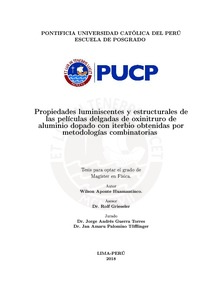Propiedades luminiscentes y estructurales de las películas delgadas de oxinitruro de aluminio dopado con iterbio obtenidas por metodologías combinatorias
Abstract
En el presente trabajo se investiga la emisión de luz y la estructura de una librería de películas delgadas de ALOxNy dopadas con Yb depositada sobre Si con la técnica de pulverización catódica por radio frecuencia a través de la aplicación de las metodologías combinatorias. La librería de películas delgadas se sometió a tratamientos térmicos de 550 °C, 650 °C y 750 °C. Posterior a cada calentamiento, se evaluó la variación en la composición atómica de la muestra y su respectiva caracterización en las propiedades luminiscentes y estructurales de la muestra. La intensidad de la emisión del Yb se incrementó con el aumento en la concentración de Yb (>3.5 at. %) en la muestra sin calentar.
Con la aplicación de los tratamientos térmicos se generó una variación en el espesor y la relación O:N de la matriz, que influyó en el incremento y/o disminución de la intensidad de la emisión de luminiscencia del Yb. Los resultados muestran la activación térmica de los iones de Yb con el aumento de la temperatura de calentamiento. Del gráfico de Arrhenius se calculó la energía de activación térmica de los iones para diferentes razones de O:N.
La más alta intensidad de emisión se obtuvo a 750 °C, en la región con una concentración inicial de Yb de ~4 at. % y relación O:N ~1.7. Los patrones de difracción de rayos-X verificaron el estado amorfo de las muestras antes y después del tratamiento térmico. En el análisis de las propiedades ópticas de las películas delgadas de ALOxNy, muestran un incremento del índice de refracción y el ancho de banda conforme aumenta el oxígeno en la muestra. In the present work the light emission and the structure of a library of thin films of ALOxNy doped with Yb deposited on Si with the sputtering technique by radio frequency at through the application of combinatorial methodologies. The library of thin films was subjected to thermal treatments of 550 °C, 650 °C and 750 °C. After each heating, the variation in the atomic composition of the sample and its respective characterization in the luminescent and structural properties of the sample was evaluated. The emission intensity of Yb increases with the increase in the concentration of Yb (>3.5 at.%) in the unheated sample. With the application of thermal treatments, a variation in the thickness and the O: N ratio of the matrix can be generated, which influenced the increase and/or decrease in the intensity of the luminescence emission of Yb. The results show the thermal activation of the levels of Yb with the increase of the heating temperature. From the Arrhenius plot, the energy of the thermal energy of the ratios is calculated for diferent ratios of O: N. The highest emission intensity was obtained at 750 °C, in the region with an initial concentration of Yb of ~4 at% and relation O: N ~1.7. The X-ray diraction patterns verify the amorphous state of the samples before and after the heat treatment. In the analysis of the optical properties of the thin lms of ALOxNy, they show an increase in the refractive index and the bandwidth as the oxygen in the sample increases.
Temas
Películas delgadas
Pulverización catódica
Óptica
Pulverización catódica
Óptica
Para optar el título de
Maestro en Física
Collections
The following license files are associated with this item:






